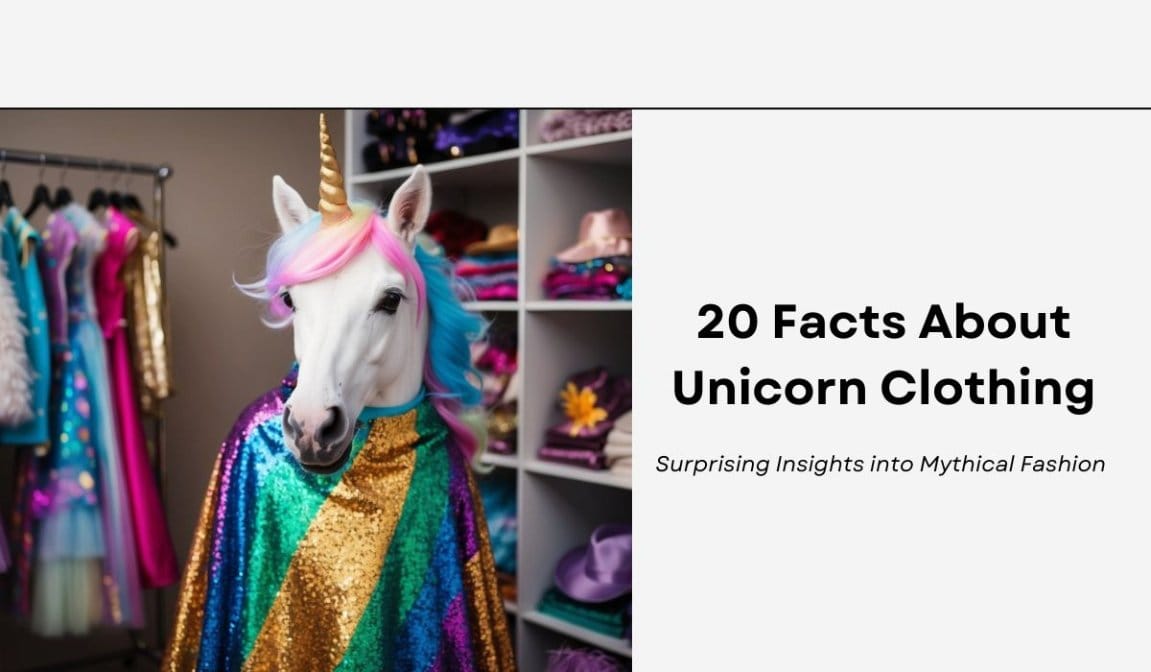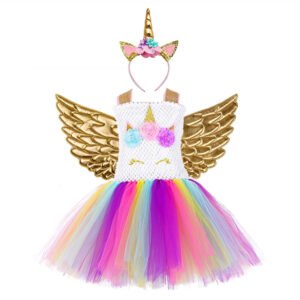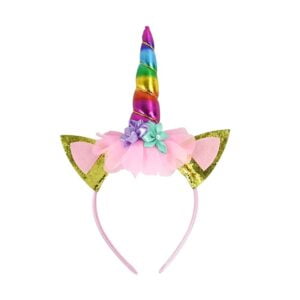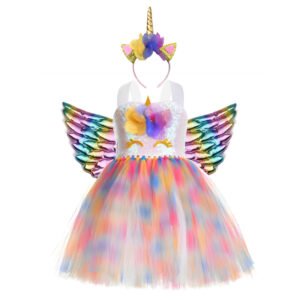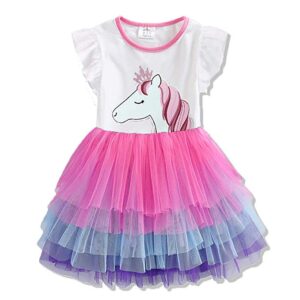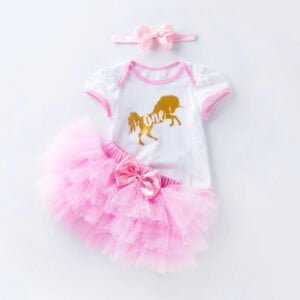From Ancient Legends to Modern Trends: The Magical Evolution of Unicorn-Inspired Fashion
Unicorns have captivated our imaginations for centuries, and their popularity extends far beyond myth and legend. Today, these magical creatures are adorning clothing and accessories worldwide, creating a vibrant fashion trend. Unicorn-themed clothing has become a global phenomenon, appealing to people of all ages and backgrounds.
From t-shirts to jumpers, leggings to shoes, unicorn motifs can be found on nearly every type of garment. The appeal of unicorn imagery extends beyond just children’s wear, with adults embracing the whimsical trend as well. This fashion craze reflects our enduring fascination with these mythical beings and their association with magic, purity, and wonder.
As we explore 20 facts about unicorn clothing, we’ll uncover the history, symbolism, and modern interpretations of these fantastic creatures in fashion. We’ll look at how unicorn designs have evolved and why they continue to enchant people around the globe.
On This Page
Key Takeaways
- Unicorn clothing appeals to all ages and reflects our fascination with magic and wonder
- Unicorn imagery on apparel ranges from subtle motifs to bold, colourful designs
- The popularity of unicorn-themed fashion speaks to a broader cultural trend of embracing fantasy in everyday life
The Historical Significance of Unicorn Imagery
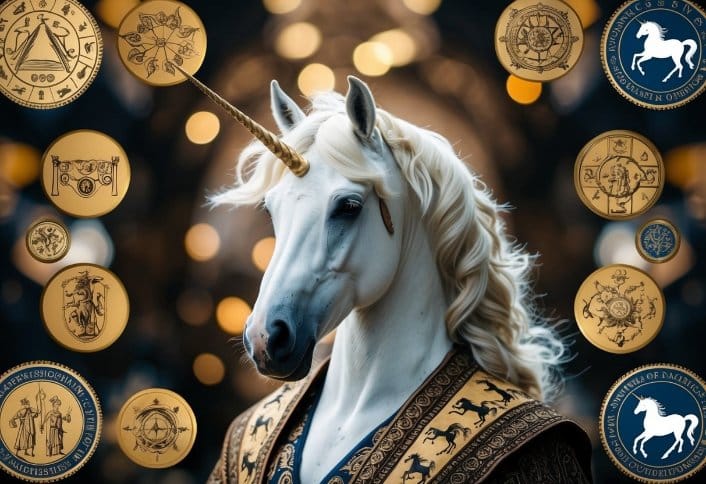
Unicorns have played a prominent role in human culture for centuries. These mythical creatures have appeared in various forms across different civilisations, influencing art, literature, and national identity.
Unicorn Myths Across Cultures
Unicorn legends can be traced back to ancient times. In Mesopotamia and the Indus Valley, early depictions resembling unicorns were often associated with gods and powerful beings. Greek historian Ctesias wrote about an “Indian wild ass”, which later transformed into the Roman unicorn.
The unicorn’s horn, called an alicorn, was believed to have healing properties. People thought it could purify water and heal wounds. This made unicorn horns highly valuable, especially among royalty.
In Chinese folklore, unicorns were seen as wise and gentle creatures. They were thought to appear only during times of peace and prosperity.
Unicorns in Medieval and Renaissance Art
During the Middle Ages, unicorns became a popular subject in European art. They often symbolised purity and innocence. The famous Unicorn Tapestries at the Metropolitan Museum of Art show the hunting of a unicorn, highlighting its importance in medieval lore.
In Christian art, unicorns were sometimes used to represent Christ. The King James Bible mentions unicorns several times, further cementing their place in religious imagery.
Renaissance artists continued to depict unicorns, often in elaborate and fantastical scenes. These paintings and tapestries showcased the unicorn’s grace and magical qualities.
National Symbolism and the Unicorn
Unicorns have also played a role in national symbolism. Perhaps the most notable example is Scotland, where the unicorn is the national animal. This tradition dates back to the 12th century.
King James III of Scotland used the unicorn on gold coins in the 15th century. When Scotland and England united in 1603, the Scottish unicorn and the English lion were combined in the royal coat of arms.
Today, unicorns can still be seen on British passports and various official documents. This enduring symbol represents Scotland’s rich history and mythical heritage.
Unicorn Horn: Myths and Mysteries
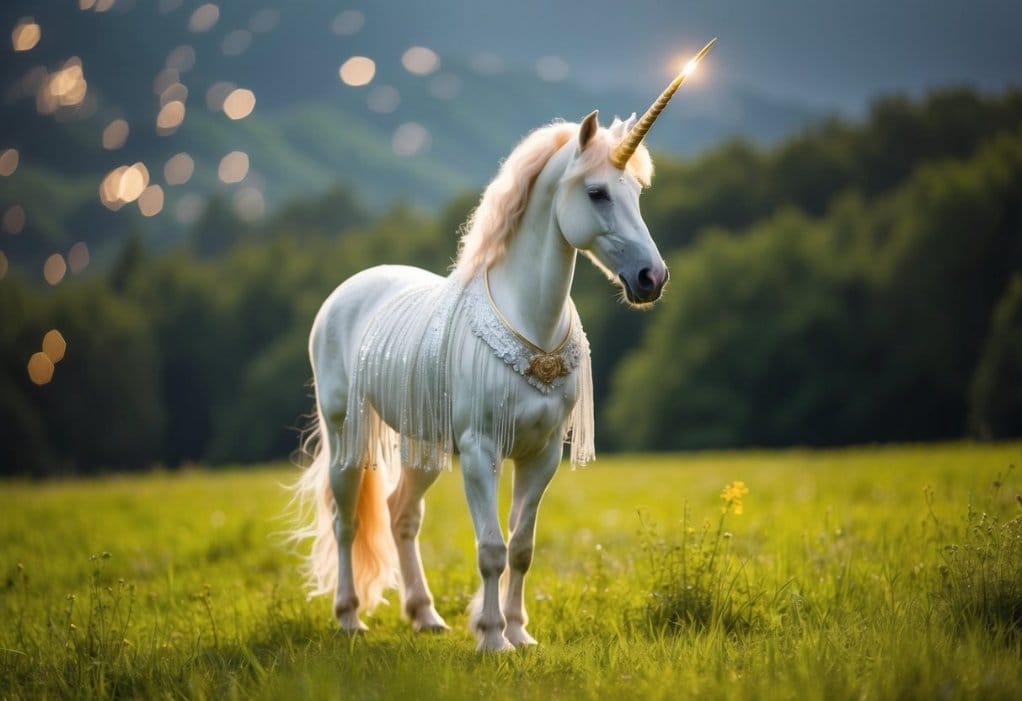
Unicorn horns have been a subject of fascination for centuries. These magical objects were thought to possess extraordinary properties and were highly sought after.
Alleged Powers and Uses
The unicorn horn was believed to have healing powers. People thought it could cure illnesses and purify water. Many believed that drinking from a cup made of unicorn horn would protect against poison.
In medieval times, royalty and the wealthy often owned what they claimed were unicorn horns. These prized possessions were used in ceremonies and as symbols of power.
Some even thought the horn could detect poisons. Legend said it would sweat or change colour if poison was present.
Historical Trade and Narwhal Tusk
A thriving trade in ‘unicorn horns’ existed for centuries. In reality, these were often narwhal tusks. Narwhals are Arctic whales with long, spiral tusks.
Traders sold narwhal tusks as unicorn horns for huge sums. They were worth more than gold. Kings and queens paid fortunes for these ‘magical’ objects.
The resemblance between narwhal tusks and the imagined unicorn horn is striking. This similarity fuelled the myth for centuries.
Even after people realised unicorns weren’t real, the trade continued. The horns were still valued for their beauty and rarity.
Magical Aspects of Unicorns
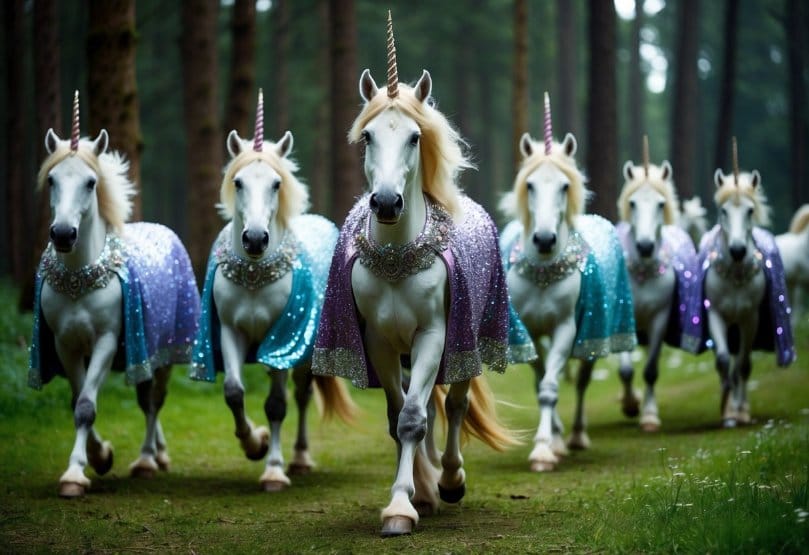
Unicorns possess extraordinary magical qualities that go beyond their stunning appearance. These mythical creatures are known for their healing powers, purity, and role in fantasy stories.
Healing and Purification
Unicorns are linked to powerful healing abilities. Their horn, called an alicorn, is said to have special properties. People once believed drinking from a cup made from a unicorn’s horn could cure illnesses.
Unicorn blood is thought to have life-giving powers. In some tales, it can bring people back from the brink of death. Unicorn tears are also magical. They’re said to heal wounds and purify water.
Some legends claim that unicorns can cleanse poisoned water simply by dipping their horn into it. This ability made them symbols of purity in many cultures.
Symbols of Purity and Grace
Unicorns are often seen as symbols of purity and innocence. Their white coats and graceful movements represent goodness and virtue. In art and stories, they’re often shown with young maidens to highlight their pure nature.
These magical creatures are also linked to good luck. Some believe that seeing a unicorn brings fortune and blessings. Their presence is thought to ward off evil and protect the innocent.
Unicorns are known for their keen ability to sense truth and lies. This skill adds to their image as noble and just creatures.
Unicorns in Modern Magic and Fantasy
Today, unicorns remain popular in fantasy stories and modern magical beliefs. They often appear in books and films as wise, powerful beings with various magical powers.
In some stories, unicorns can fly, become invisible, or speak with humans. They might have the power to grant wishes or see the future. These abilities make them sought-after allies for heroes in fantasy tales.
Unicorns also feature in modern magical practices. Some people use unicorn imagery in spells or meditation for purification and healing. Unicorn-themed items are popular in New Age shops and spiritual practices.
Conceptual Evolution of Unicorns
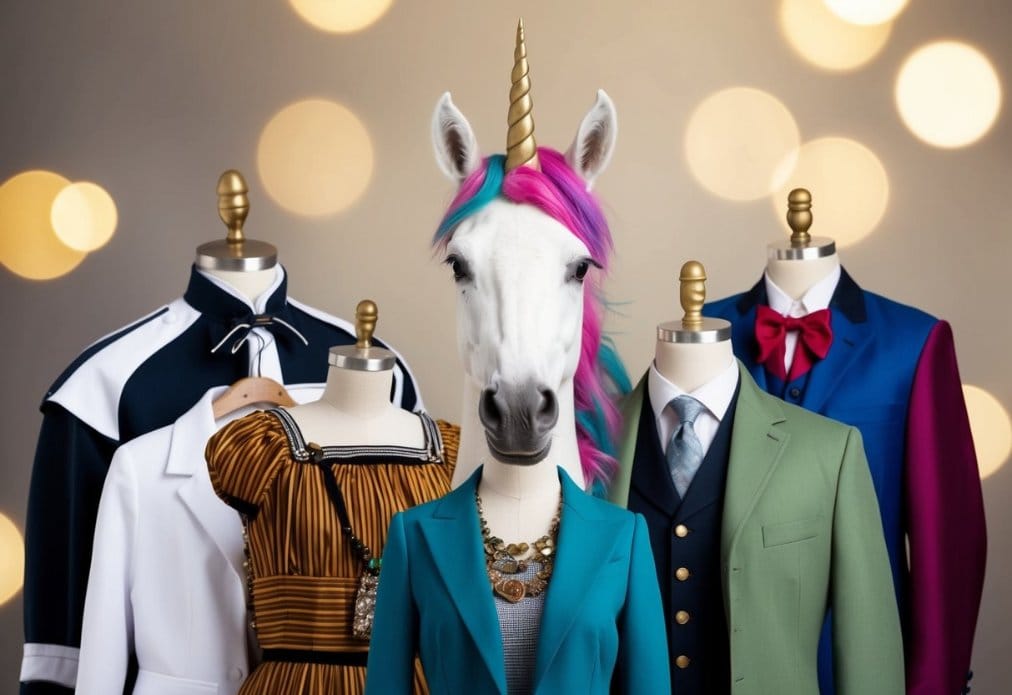
Unicorns have changed greatly in our minds over time. From old stories to modern science, these magical creatures have taken many forms.
From Ancient Texts to Modern Interpretation
The idea of unicorns began long ago. Ctesias, a Greek writer, first wrote about them around 400 BCE. He described a wild donkey with a coloured horn.
Saint Isidore later wrote about unicorns in the 7th century. He said they were fierce beasts that could only be caught by a young woman.
In China, people told stories of the qilin. This creature looked a bit like a unicorn but had scales and sometimes two horns.
Modern stories, like ‘The Last Unicorn’, show unicorns as pure and magical. They often have white coats and spiral horns.
Scientific Explanations and Genetic Mutations
Some think unicorns might have been real animals seen wrongly. The Siberian unicorn, or Elasmotherium, was a huge rhino with one horn. It lived long ago but died out before humans wrote about unicorns.
Scientists have looked at genetic mutations in other animals. Some deer and goats have been born with one horn in the middle of their heads.
These rare mutations might explain some unicorn stories. But they don’t account for all the magic people have added to unicorn tales over time.
Unicorns in Literature and Popular Media
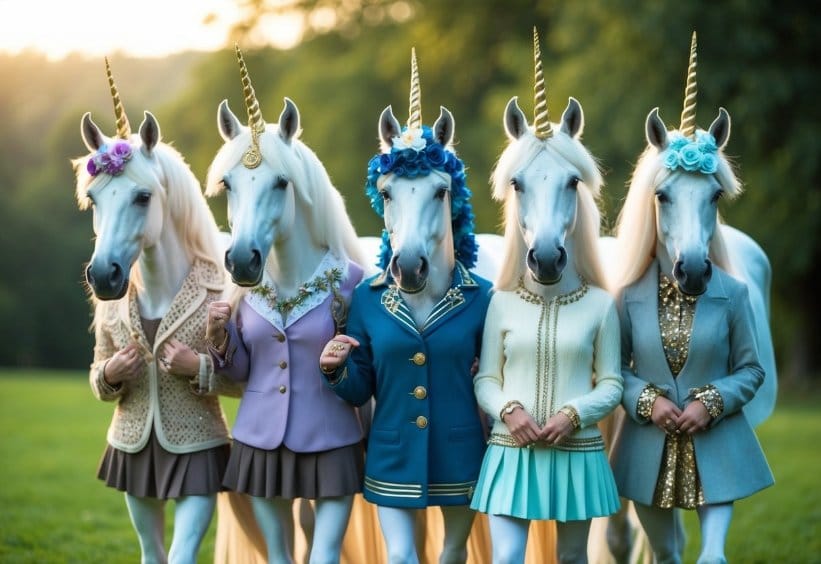
Unicorns have captivated readers and viewers for centuries, appearing in various forms of storytelling and art. These mythical creatures have left an indelible mark on our cultural imagination.
Influential Literature and Tales
Unicorns in literature have a rich history dating back to ancient texts. The Greek physician Ctesias described a one-horned creature in his work “Indica”, marking one of the earliest known references to unicorns.
Medieval bestiaries often featured unicorns, portraying them as symbols of purity and grace. These texts helped solidify the unicorn’s place in European folklore.
In modern literature, unicorns continue to enchant readers. Peter S. Beagle’s “The Last Unicorn” explores themes of identity and loss through a unicorn’s journey. This beloved novel was later adapted into an animated film, introducing the story to new generations.
Visual Arts and Unicorn Tapestries
Unicorns have been a popular subject in visual arts for centuries. The most famous depictions are the “Unicorn Tapestries”, dating back to the 15th century.
These intricate tapestries tell the story of a unicorn hunt, blending religious symbolism with courtly romance. The final scene, showing a tamed unicorn in captivity, has become an iconic image in art history.
Renaissance artists often included unicorns in their paintings, typically as symbols of purity or as companions to virtuous maidens. These visual representations helped cement the unicorn’s place in Western cultural imagination.
Unicorns in 21st Century Pop Culture
In recent years, unicorns have experienced a resurgence in popularity, especially in children’s media and merchandise. They feature prominently in animated series, toys, and even food products.
The Harry Potter series introduced readers to unicorns as magical creatures living in the Forbidden Forest. This portrayal brought unicorns to a new generation of fans.
The Invisible Pink Unicorn, a satirical deity, emerged as a parody of religious beliefs, demonstrating the unicorn’s adaptability in modern discourse.
Social media has further popularised unicorns, with trends like unicorn-themed foods and makeup gaining widespread attention. This renewed interest has led to a surge in unicorn-themed products and experiences, from inflatable pool floats to themed cafes.
Unicorn-Related Celebrations and Social Customs
Unicorn-themed events and practices have gained popularity in recent years. These celebrations reflect the magical creature’s enduring appeal in modern culture.
National Unicorn Day and Other Festivities
National Unicorn Day is celebrated on 9 April. It’s a time for unicorn enthusiasts to express their love for these mythical beings through various activities and events.
Many towns host unicorn-themed parades where people dress up in colourful costumes. Children often participate in unicorn-inspired crafts and face painting.
Some places offer ‘unicorn hunting licences’ as novelty items. These playful documents add a touch of whimsy to the festivities.
Unicorn as Inspiration in Daily Life
Unicorns have become a symbol of freedom and divine truth in popular culture. Many people incorporate unicorn motifs into their daily lives as a reminder of these ideals.
Unicorn-themed clothing and accessories are widely popular. Items like t-shirts, bags, and jewellery often feature unicorn designs.
Some believe that unicorn symbols bring good luck. This has led to a trend of using unicorn imagery in home decor and personal items.
Unicorn-themed events such as birthday parties and baby showers have become increasingly common. These celebrations often include unicorn-shaped cakes, pastel decorations, and magical activities.
Unicorn Apparel and Accessories
Unicorn-themed clothing and accessories have become a popular trend, blending fantasy with fashion. These items often feature sparkle and bright colours to capture the magical essence of unicorns.
Recommended products
Trends in Fashion and Costumery
Unicorn-inspired fashion has taken the world by storm. Unicorn onesies and dressing gowns are popular choices for loungewear, especially for children. These cosy outfits often come in soft pastels with rainbow accents.
For everyday wear, unicorn t-shirts, jumpers, and dresses are common. Many feature glittery designs or sequins to add a touch of sparkle. Accessories like unicorn-themed bags, hair clips, and jewellery complete the look.
Costumes are another big part of unicorn fashion. Full-body unicorn suits with colourful manes and tails are favourites for fancy dress parties. Some even have light-up horns for extra magic.
Cultural Significance of Unicorn Clothing
Unicorn clothing represents more than just a fashion statement. It embodies ideals of beauty, purity, and grace associated with these mythical creatures. Many people, especially young girls, wear unicorn clothes to express their love for fantasy and magic.
Unicorn apparel often brings families together. Parents and children can match in unicorn pyjamas or costumes, creating fun bonding experiences. This shared interest helps strengthen family ties.
The popularity of unicorn clothing also reflects a broader cultural trend towards escapism and whimsy. In a sometimes difficult world, dressing up as a magical creature offers a brief retreat into a more enchanted realm.
Frequently Asked Questions
Unicorn-themed clothing for children offers magical designs and educational benefits. Parents can find safe, quality options that cater to different age groups and cultural interests.
What are the key features of unicorn-themed clothing for children?
Unicorn-themed clothing for children often features vibrant colours and whimsical designs. Common elements include rainbow patterns, glitter accents, and unicorn motifs.
Many items have soft, comfortable fabrics suitable for active play. Popular styles include t-shirts, dresses, pyjamas, and accessories like backpacks and hair clips.
How does unicorn clothing for toddlers differ from those designed for older kids?
Toddler unicorn clothing typically has simpler designs and more practical features. This might include easy-to-use fastenings and durable fabrics that withstand frequent washing.
Older children’s unicorn clothing often has more complex patterns and trendy styles. These items may incorporate fashion-forward elements like sequins or holographic prints.
What are some interesting details about the incorporation of unicorns in fashion?
Unicorn fashion often draws inspiration from mythical stories and cultural symbolism. Designers may use horn-shaped accessories or iridescent fabrics to capture the unicorn’s magical essence.
Some clothing lines incorporate educational elements, such as glow-in-the-dark constellations or number patterns, to blend learning with style.
In what ways does clothing featuring unicorns stimulate learning for primary school-age children?
Unicorn-themed clothing can spark curiosity about mythology and folklore. This interest may encourage children to read more about magical creatures and ancient cultures.
Some designs include educational elements like counting games or colour-matching activities. These features can make getting dressed a fun learning experience.
What cultural significance do unicorns hold that is reflected in children’s apparel?
Unicorns have long been symbols of purity and magic in many cultures. Children’s clothing often reflects this by using white or pastel colours.
In some designs, unicorns are paired with rainbows or stars, representing hope and dreams. This symbolism can inspire children to believe in the extraordinary.
How can parents ensure the quality and safety of unicorn-themed clothing for their children?
Parents should check for age-appropriate designs and sturdy construction. Look for clothing made from non-toxic, hypoallergenic materials to prevent skin irritation.
It’s important to choose items with secure fastenings and avoid small, detachable parts that could pose a choking hazard. Always follow care instructions to maintain the clothing’s quality and safety features.
Related Post: What You Need to Know About Unicorn Clothing: Essential Tips for Magical Fashion

